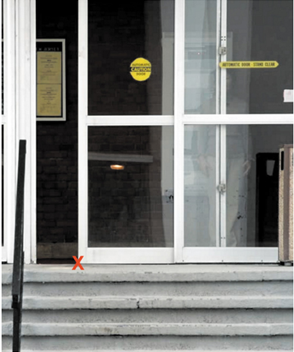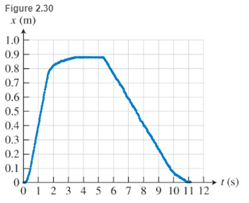
Concept explainers
Automatic sliding doors The first automatic sliding doors were described by Hero of Alexandria almost 2000 years ago. The doors were moved by hanging containers that were filled with water. Modern sliding doors open or close automatically. They are equiped with sensors that detect the proximity of a person and an electromic circuit that processes the signals from the sensors and drives the electomotor-based system that moves the doors. The sensors typically emit pulses of infrared light or ultrasound and detect the reflected pulses. By measuring the delay between emitted and received pulses, the system can determine the distance to the object from which the pulse was reflected. The whole system must be carefully designed to ensure safe and accurate functioning. Designers of such doors take into account several variables such as typical walking speeds of people and their dimensions.

Let’s try to learn more about automatic sliding doors by analyzing the motion of a single-side automatic sliding door when a person is walking through the door. Figure 2.30 shows the position-versus-time graph of the motion of the edge of the door (marked with a red cross in the photo) from the moment the door starts opening to when the door is closed while a person walks toward and through the door. The doors are adjusted to start opening when a person is 2.0 m away.

A person is walking at constant speed of 1.15 m/s toward and through the sliding door. How far from the door is the person when the door starts closing?
a. 2.3 m
b. 4.3 m
c. 6.3 m
d. 8.3m
Want to see the full answer?
Check out a sample textbook solution
Chapter 2 Solutions
College Physics
Additional Science Textbook Solutions
Microbiology with Diseases by Body System (5th Edition)
Organic Chemistry (8th Edition)
Applications and Investigations in Earth Science (9th Edition)
Genetic Analysis: An Integrated Approach (3rd Edition)
Chemistry: An Introduction to General, Organic, and Biological Chemistry (13th Edition)
Microbiology: An Introduction
- You are working with a team that is designing a new roller coaster-type amusement park ride for a major theme park. You are present for the testing of the ride, in which an empty 150 kg car is sent along the entire ride. Near the end of the ride, the car is at near rest at the top of a 100 m tall track. It then enters a final section, rolling down an undulating hill to ground level. The total length of track for this final section from the top to the ground is 250 m. For the first 230 m, a constant friction force of 370 N acts from computer-controlled brakes. For the last 20 m, which is horizontal at ground level, the computer increases the friction force to a value required for the speed to be reduced to zero just as the car arrives at the point on the track at which the passengers exit. (a) Determine the required constant friction force (in N) for the last 20 m for the empty test car. Write AK + AU + AE int = W+Q + TMW + TMT + TET + TER for the car-track-Earth system and solve for…arrow_forward= 12 kg, and m3 Three objects with masses m₁ = 3.8 kg, m₂ find the speed of m3 after it moves down 4.0 m. m/s 19 kg, respectively, are attached by strings over frictionless pulleys as indicated in the figure below. The horizontal surface exerts a force of friction of 30 N on m2. If the system is released from rest, use energy concepts to m m2 m3 iarrow_forwardThree objects with masses m₁ = 3.8 kg, m₂ = 12 kg, and m 19 kg, respectively, are attached by strings over frictionless pulleys as indicated in the figure below. The horizontal surface exerts a force of friction of 30 N on m2. If the system is released from rest, use energy concepts to find the speed of m¸ after it moves down 4.0 m. m/s m m2 mgarrow_forward
- In order for Jane to return to base camp, she needs to swing across a river of width D that is filled with alligators. She must swing into a wind exerting constant horizontal force F, F = 110 N, L = 40.0 m, 0 = 50.0°, and her mass to be 50.0 kg. Wind →F Tarzan! Jane (a) with what minimum speed (in m/s) must Jane begin her swing to just make it to the other side? (If Jane can make it across with zero initial velocity, enter 0.) m/s on a vine having length L and initially making an angle with the vertical (see below figure). Take D = 48.0 m, (b) Shortly after Jane's arrival, Tarzan and Jane decide to swing back across the river (simultaneously). With what minimum speed (in m/s) must they begin their swing? Assume that Tarzan has a mass of 80.0 kg. m/sarrow_forwardR=2.00 12V 2.00 4.00 4.002 What is the current in one of the 4.0 Q resistors? An isolated point charge q is located at point X. Two other points Y and Z are such that YZ2 XY. Y X What is (electric field at Y)/(electric field at Z)?arrow_forwardTwo objects (m₁ = 4.75 kg and m₂ 2.80 kg) are connected by a light string passing over a light, frictionless pulley as in the figure below. The 4.75-kg object is released from rest at a point h = 4.00 m above the table mg m (a) Determine the speed of each object when the two pass each other. m/s (b) Determine the speed of each object at the moment the 4.75-kg object hits the table. m/s (c) How much higher does the 2.80-kg object travel after the 4.75-kg object hits the table? marrow_forward
- A cell of negligible internal resistance is connected to three identical resistors. The current in the cell is 3.0 A. The resistors are now arranged in series. What is the new current in the cell?arrow_forwardA negatively charged sphere is falling through a magnetic field. north pole of magnet direction of motion south pole of magnet What is the direction of the magnetic force acting on the sphere?arrow_forwardElectrons in a conductor are moving down the page. A proton outside the wire is moving to the right. What is the direction of the magnetic force acting on the proton?arrow_forward
- What is the resistance of an ideal voltmeter and the resistance of an ideal ammeter? Resistance of an ideal voltmeter Resistance of an ideal ammeter infinite A. zero B. zero zero C. infinite infinite D. infinite zeroarrow_forwardvariable resistor with a resistance range of 0 to 6.0 KQ is connected in series with two resistors of fixed value 6.0 KQ. The cell in the circuit has an emf of 18 V and a negligible internal resistance. 18 V X Y 6.0 ΚΩ 6.0 ΚΩ 0 - 6.0 ΚΩ What is the maximum range of potential difference that can be observed between X and Y?arrow_forwardA positive point charge of magnitude 1.0 μC and a point charge q are separated by a distance d. electron 1.0 με An electron is placed at a distance d from the +1.0 μC charge. The electric force on the electron is zero. What is q?arrow_forward
 College PhysicsPhysicsISBN:9781305952300Author:Raymond A. Serway, Chris VuillePublisher:Cengage Learning
College PhysicsPhysicsISBN:9781305952300Author:Raymond A. Serway, Chris VuillePublisher:Cengage Learning Principles of Physics: A Calculus-Based TextPhysicsISBN:9781133104261Author:Raymond A. Serway, John W. JewettPublisher:Cengage Learning
Principles of Physics: A Calculus-Based TextPhysicsISBN:9781133104261Author:Raymond A. Serway, John W. JewettPublisher:Cengage Learning An Introduction to Physical SciencePhysicsISBN:9781305079137Author:James Shipman, Jerry D. Wilson, Charles A. Higgins, Omar TorresPublisher:Cengage Learning
An Introduction to Physical SciencePhysicsISBN:9781305079137Author:James Shipman, Jerry D. Wilson, Charles A. Higgins, Omar TorresPublisher:Cengage Learning
 College PhysicsPhysicsISBN:9781285737027Author:Raymond A. Serway, Chris VuillePublisher:Cengage Learning
College PhysicsPhysicsISBN:9781285737027Author:Raymond A. Serway, Chris VuillePublisher:Cengage Learning Physics for Scientists and EngineersPhysicsISBN:9781337553278Author:Raymond A. Serway, John W. JewettPublisher:Cengage Learning
Physics for Scientists and EngineersPhysicsISBN:9781337553278Author:Raymond A. Serway, John W. JewettPublisher:Cengage Learning





